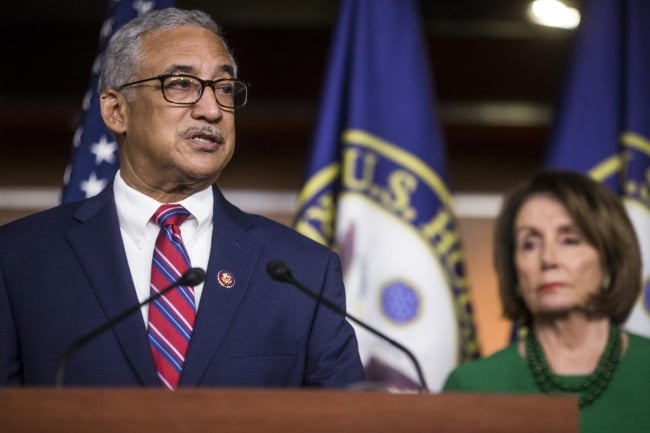You have /5 articles left.
Sign up for a free account or log in.

House Education and Labor Committee chair Bobby Scott (left)
Zach Gibson/Getty Images
A long-awaited increase to the maximum Pell Grant was passed by the House of Representatives Friday, but with a catch—it will only be available to students attending nonprofit institutions. The provision has raised questions about the appropriate way to hold for-profit colleges accountable, as 17 House Democrats publicly opposed the exclusion ahead of the legislation’s final vote.
Under President Biden and congressional Democrats’ $1.75 trillion social spending package, the Pell Grant award—financial aid for low- and moderate-income students that doesn’t have to be repaid—would be increased by $550 per year. But the approximately 900,000 Pell Grant recipients who attend proprietary institutions won’t be eligible to receive the extra funds, a big change in how the program has historically operated.
The provision only affects the $550 increase—for-profit students would still be eligible for the current maximum Pell Grant, which is $6,495.
Democrats, both in Congress and in presidential administrations, have sought to crack down on for-profit institutions, which they view as largely predatory colleges with poor outcomes for their students. House Education and Labor Committee chair Bobby Scott, a Democrat from Virginia, said during a congressional hearing last week that the committee couldn’t separate “good for-profits from bad for-profits, and so the decision was made not to let any for-profits benefit.”
However, for-profit advocates and others aren’t convinced that rewriting some of the rules of how Pell Grants work is the way to hold bad institutions accountable.
“We’ve never distinguished student access to Title IV [Higher Education Act] programs based on the tax status of the institution a student chooses to attend, and … to start doing so now is a slippery slope as higher education becomes increasingly subject to partisan divisions,” said John Przypyszny, a higher education lawyer who has clients from all sectors.
The National Association of Student Financial Aid Administrators, or NASFAA, has raised concerns about the provision from an administrative perspective, with President and CEO Justin Draeger noting that the change would add greater complexity to a financial aid system that advocates, lawmakers and policy makers have been working for years to simplify.
“There are all sorts of questions about it,” Draeger told Inside Higher Ed. “What about future increases through appropriations? Would you sometimes have restricted increases and sometimes not have restricted increases? If the idea is we’re going to tell students and families how much they qualify for in Pell Grants nearly at the time they file their taxes, creating different Pell schedules takes us a step away from that.”
Others are highlighting the provision’s potential to negatively impact low-income students. A group of 17 House Democrats sent a letter to House leadership arguing that “this proposal hurts students, not institutions,” and contradicts the policy goals of the Build Back Better agenda by impacting first-generation students and students of color, in particular.
“There are going to be a significant number of students that will potentially be at a disparate level of financial aid in relation to their peers simply because of the institution they chose to attend,” said Tom Netting, CEO of TEN Government Strategies and an executive director of the Career Schools Private Education Network.
The federal government has other ways of holding the for-profit sector accountable without impacting students taking advantage of the Pell Grant program. The Department of Education is revisiting two regulations through negotiated rule making—the 90-10 rule and gainful employment—which are geared toward for-profit institutions.
“We need to do more to bring accountability to all sectors of higher education; however, punishing students does not accomplish that objective,” the 17 Democrats wrote. “Any accountability rules should be focused on institutions, not students.”
Still, excluding for-profit students from the Pell Grant increase has support beyond the legislators who included it in the Build Back Better Act. The Institute for College Access and Success, the Education Trust, and the New America higher education program joined 22 other organizations in calling the provision’s inclusion “an appropriate decision” for focusing the Pell Grant increase so that it maximizes federal resources.
“For-profit colleges spend just 26 percent of the tuition revenue they receive on instruction, compared to 79 percent at nonprofit colleges and an even higher percent at four-year public colleges,” the organizations wrote in a letter to Democratic congressional leaders, adding that “since 2009–10, more than $9 billion in Pell grants have gone to for-profit schools that have collapsed.”
Now that the Build Back Better Act has passed the House with the provision intact, it’ll be up for debate in the Senate, where advocates are pushing for the support of an amendment that would include for-profits in the Pell Grant increase. And they’re feeling confident that senators will ultimately vote in their favor.
“In a House of Representatives with a five-vote Democratic margin, we were able to get 17 Democrats to support our position,” said Jason Altmire, president and CEO of Career Education Colleges and Universities, which represents for-profit institutions. “We’re very confident moving into the Senate in a 50-50 dynamic that when an amendment is offered, we’ll be able to make the case that our students should be included.”
The Senate debate will be one of the last hopes for-profit students and advocates—if it’s signed into law by Biden, challenging the provision would be an uphill battle.
“Once Congress passes a law, then you would have to argue that it’s unconstitutional, and that’s a more complicated question,” Przypyszny said. “That said, there are often challenges to the implementation of laws that Congress passes—look what happened with Obamacare.”



